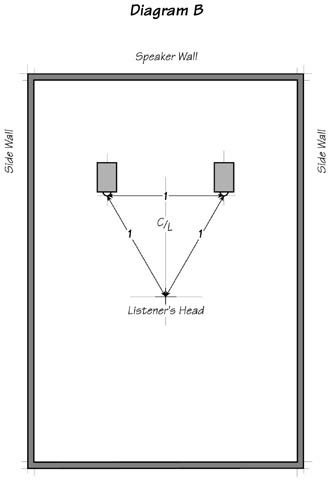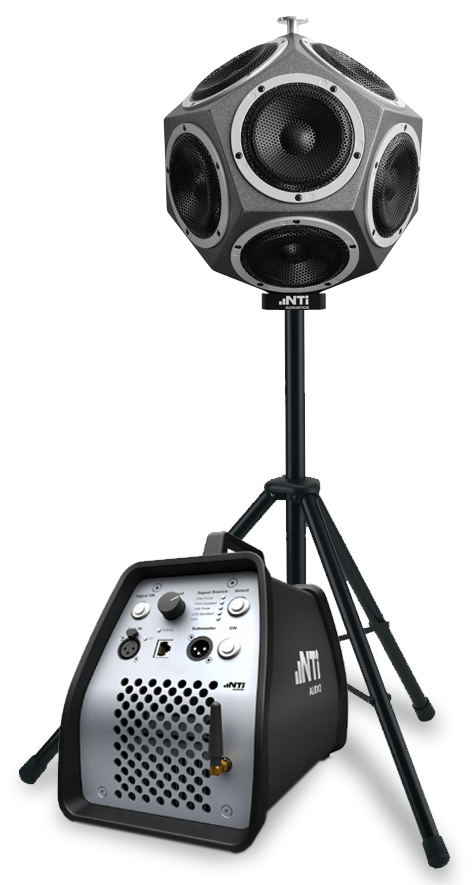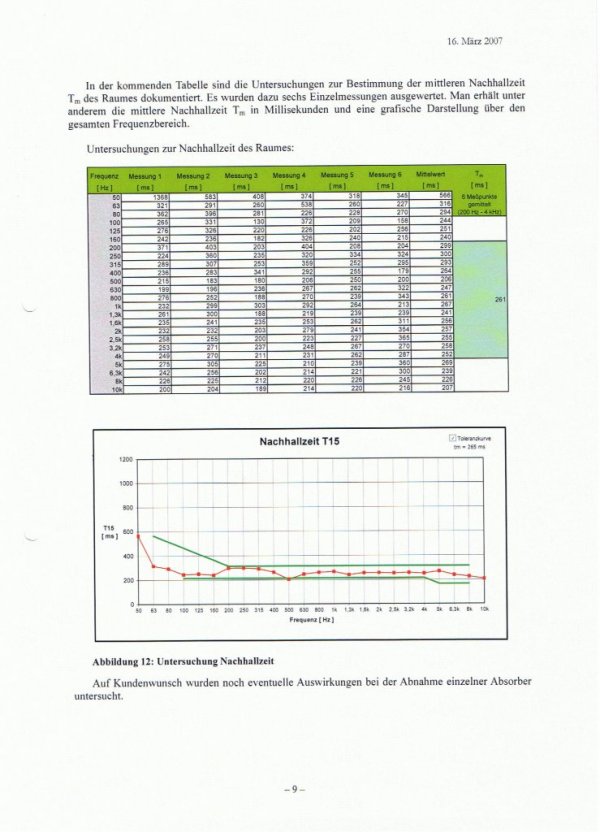Wow. I don't think I've ever seen measured performance that good. Congratulations. I'm sure the room sounds great.
Dedicated audio room build thread aka The Big Dig
- Thread starter HughP3
- Start date
You are using an out of date browser. It may not display this or other websites correctly.
You should upgrade or use an alternative browser.
You should upgrade or use an alternative browser.
had Mike Burns from WolfSong Audio come by today to further measure the room.
to recap: the room is 12’ 2” high, 21’ wide and 31’ long. QRD diffusers are 16” deep.
setup guru Jim Smith finalized the speaker position. The speakers are now almost mid room. Jim was very pleased with the outcome.
software used:
Calibrated OmniMic V2 running the OmniMic RTA software. Mic was equidistant from the AMT tweeters at 13’ 7.5 “ Mic was 42” off the floor.
The graphs are labeled as to what was measured. All measurements were done at a more realistic 85db reference. 1/6 octave smoothing was used. Mikes summary is below the attachments. I dont pretend to know how to interpret all of these which is why i asked Mike to summarize for me.
Folks This is it for measurements. Not going to run anymore. I am sure this will not satisfy everyoneand i am sure the comments will be entertaining!
Mikes Summary:
Overall the Bass region runs very evenly with no more than 5 db variation from reference and the room does not hold on the reverberant notes in the 200 Hz and below region.
Listening notes: Bass is explosive and nuanced. Timber and tonal cues in the tambor are spot on. The weight is tremendous while having no negative effect on the overall soundstage during deep and loud passages. Kick drums are particularly fun with “kick you in the chest” impact.
Image size is slightly larger than life in a good way. Since the Barn is a quite large space, the image size fits with the scale of the room and the speakers. Multiple singers on stage are easily differentiated in space and tone. The system scales wonderfully from single instrument to full on live rock recordings.
The measurements indicate a dead room, overly dampened. As I had anticipated, way too much absorption. This is the opposite of a reverberant room. Ideal acoustic spaces allow the low frequency decay of notes and their harmonics and do not snuff them. An ideal room response will exhibit homogeneous spectral energy distribution, balanced. This is why Jim Smith set-up the listening position in a near-field arrangement. My advice is to remove a substantial number of those carbon panels, guided by measurements of a calibrated source.
Too much of a good thing is not a good thing. This is why I always advise people desiring an engineered room to be careful and know what they are doing as it is extremely difficult to achieve optimal room acoustics across the frequency spectrum, from a variety acoustic sources.
It is more effective to implement diffusion and diffraction than absorption as they are more analogous to acoustic spaces were live music is performed, heard, recorded, and reproduced.
Lucky for you, the near-field arrangement will mitigate a large part of the room anomalies.
Last edited:
LOLThe measurements indicate a dead room, overly dampened. As I had anticipated, way too much absorption. This is the opposite of a reverberant room. Ideal acoustic spaces allow the low frequency decay of notes and their harmonics and do not snuff them. An ideal room response will exhibit homogeneous spectral energy distribution, balance. This is why Jim Smith set-up the listening position in a near-field arrangement. My advice is to remove a substantial number of those carbon panels, guided by measurements of a calibrated source.
Too much of a good thing is not a good thing. This is why I always advice people desiring an engineered room to be careful and know what they are doing as it is extremely difficult to achieve optimal room acoustics across the frequency spectrum, from a variety acoustic sources.
Lucky for you, the near-field arrangement will mitigate a large part of the room anomalies.
The measurements speak for themselves.
Hopefully others on this forum will also be knowledgeable enough to interpret these measurements. Don’t be misguided by the flat frequency response as that is indicative of measuring the speaker/source output and not the room. The spectral decay are the measurements that provide the insight into the room’s response to those excitations.
Last edited:
Nice, the benefits of 7500+ cubic feet. The sound just dissipates with effective decay. Enjoy!had Mike Burns from WolfSong Audio come by today to further measure the room.
to recap: the room is 12’ 2” high, 21’ wide and 31’ long. QRD diffusers are 16” deep.
setup guru Jim Smith finalized the speaker position. The speakers are now almost mid room. Jim was very pleased with the outcome.
software used:
Calibrated OmniMic V2 running the OmniMic RTA software. Mic was equidistant from the AMT tweeters at 13’ 7.5 “ Mic was 42” off the floor.
The graphs are labeled as to what was measured. All measurements were done at a more realistic 85db reference. 1/6 octave smoothing was used. Mikes summary is below the attachments. I dont pretend to know how to interpret all of these which is why i asked Mike to summarize for me.
Folks This is it for measurements. Not going to run anymore. I am sure this will not satisfy everyoneand i am sure the comments will be entertaining!
Mikes Summary:
Overall the Bass region runs very evenly with no more than 5 db variation from reference and the room does not hold on the reverberant notes in the 200 Hz and below region.
Listening notes: Bass is explosive and nuanced. Timber and tonal cues in the tambor are spot on. The weight is tremendous while having no negative effect on the overall soundstage during deep and loud passages. Kick drums are particularly fun with “kick you in the chest” impact.
Image size is slightly larger than life in a good way. Since the Barn is a quite large space, the image size fits with the scale of the room and the speakers. Multiple singers on stage are easily differentiated in space and tone. The system scales wonderfully from single instrument to full on live rock recordings.
A remarkable project in every way. Thank you for showing it to us. Especially thank you for showing us the room measurements. Although one can never say how a component sounds from measurements you can tell a lot about room measurements. I believe anyone who ever struggled with room measurement will know exactly how that room sound. Rather, how it does not sound because that room will add exactly nothing. Whether one likes it or not ,is a personal preference but it stays a fantastic achievement and easily explain that the move to the seemingly obscenely powerful Gryphon amplifier was a must.
Thank you for sharing such a journey with us especially as tying down the original supplier seems rather difficult but he does seem to know what he is doing.
Thank you for sharing such a journey with us especially as tying down the original supplier seems rather difficult but he does seem to know what he is doing.
First of all impressive roomhad Mike Burns from WolfSong Audio come by today to further measure the room.
to recap: the room is 12’ 2” high, 21’ wide and 31’ long. QRD diffusers are 16” deep.
setup guru Jim Smith finalized the speaker position. The speakers are now almost mid room. Jim was very pleased with the outcome.
software used:
Calibrated OmniMic V2 running the OmniMic RTA software. Mic was equidistant from the AMT tweeters at 13’ 7.5 “ Mic was 42” off the floor.
The graphs are labeled as to what was measured. All measurements were done at a more realistic 85db reference. 1/6 octave smoothing was used. Mikes summary is below the attachments. I dont pretend to know how to interpret all of these which is why i asked Mike to summarize for me.
Folks This is it for measurements. Not going to run anymore. I am sure this will not satisfy everyoneand i am sure the comments will be entertaining!
Mikes Summary:
Overall the Bass region runs very evenly with no more than 5 db variation from reference and the room does not hold on the reverberant notes in the 200 Hz and below region.
Listening notes: Bass is explosive and nuanced. Timber and tonal cues in the tambor are spot on. The weight is tremendous while having no negative effect on the overall soundstage during deep and loud passages. Kick drums are particularly fun with “kick you in the chest” impact.
Image size is slightly larger than life in a good way. Since the Barn is a quite large space, the image size fits with the scale of the room and the speakers. Multiple singers on stage are easily differentiated in space and tone. The system scales wonderfully from single instrument to full on live rock recordings.
One little question,I missed the important rt60 mesasurements , thats easier to say how the room without speakers sounds. Have fun and happy listening to music
Carlos,The measurements indicate a dead room, overly dampened. As I had anticipated, way too much absorption. This is the opposite of a reverberant room. Ideal acoustic spaces allow the low frequency decay of notes and their harmonics and do not snuff them. An ideal room response will exhibit homogeneous spectral energy distribution, balanced. This is why Jim Smith set-up the listening position in a near-field arrangement. My advice is to remove a substantial number of those carbon panels, guided by measurements of a calibrated source.
Too much of a good thing is not a good thing. This is why I always advise people desiring an engineered room to be careful and know what they are doing as it is extremely difficult to achieve optimal room acoustics across the frequency spectrum, from a variety acoustic sources.
It is more effective to implement diffusion and diffraction than absorption as they are more analogous to acoustic spaces were live music is performed, heard, recorded, and reproduced.
Lucky for you, the near-field arrangement will mitigate a large part of the room anomalies.
You have no idea what you’re talking about here. It’s not nearfield-the chairs are far back from the speaker. It’s a standard placement formula developed by Jim Smith based on thousands of meticulous room setups…and that is refined by how Jim’s test tracks play back to him. Also, the measurements for this room are excellent by any measure and most importantly, it is one of the best rooms I have heard and I have been to hundreds.
Furthermore, those carbon panels have been carefully placed after much experimentation.
The sound is effortless, engaging, and musical. The notes decay perfectly and the room is not at all overdamped.
Carlos,
You have no idea what you’re talking about here. It’s not nearfield-the chairs are far back from the speaker. It’s a standard placement formula developed by Jim Smith based on thousands of meticulous room setups…and that is refined by how Jim’s test tracks play back to him. Also, the measurements for this room are excellent by any measure and most importantly, it is one of the best rooms I have heard and I have been to hundreds.
Furthermore, those carbon panels have been carefully placed after much experimentation.
The sound is effortless, engaging, and musical. The notes decay perfectly and the room is not at all overdamped.
Let’s do some basic analysis:
1. Length of the room is “31’ long” => middle of the room is15.5 feet from the front wall and back wall
2. “The speakers are now almost mid room”, let’s assume 13.5 feet from the front wall
3. The “Mic was equidistant from the AMT tweeters at 13’ 7.5 “”
4. I assume that the listening position is not against the back wall, like Jay’s from Jay’s Audio Lab, and that the measurement-microphone was located at the listening position. Given that the room is “21’ wide”, that puts the listening position about 11 feet in front of the plane of the speakers
5. Definition of near-field arrangement: “In the near field position the speakers and the listener’s head are the points of an equilateral triangle. Near field listening gives the perfect stereo field. It is frequently used in the recording studio to position the microphones and the voice in the mix. The near field listening position is determined by the "center to center" distance of the speakers and the distance to the listener’s head. It does not refer to the room in any way.”
6. The importance of the near-field listening arrangement: “where you are hearing more of the speaker and less of the room's reflections”

Hopefully that was simple enough for even you to follow. May I suggest that you better learn and know your shit before you challenge me.
Last edited:
Jim Smith came to voice my system to the room. He generally ends up with a triangle where tweeter to tweeter is roughly 83% of the distance of the center point between the speakers to the listener.
Jim did a great job with my old system and I suspect Hugh is benefiting from that visit tremendously.
Hugh might share some of these distances for clarity. I commend Hugh for sharing the measurements and the whole project with us. It was a monumental effort and I appreciate learning what others are doing in this hobby.
Jim did a great job with my old system and I suspect Hugh is benefiting from that visit tremendously.
Hugh might share some of these distances for clarity. I commend Hugh for sharing the measurements and the whole project with us. It was a monumental effort and I appreciate learning what others are doing in this hobby.
very kind Peter, thank youJim Smith came to voice my system to the room. He generally ends up with a triangle where tweeter to tweeter is roughly 83% of the distance of the center point between the speakers to the listener.
Jim did a great job with my old system and I suspect Hugh is benefiting from that visit tremendously.
Hugh might share some of these distances for clarity. I commend Hugh for sharing the measurements and the whole project with us. It was a monumental effort and I appreciate learning what others are doing in this hobby.
Hugh, congratulations on creating a spectacular listening environment and for the measured results. I am in awe…
David
David
Hugh, thanks for sharing your project and the journey. i Have no doubt the system sounds spectacular. It’s been fun to watch and learn as you progressed.
So, if you've got space to setup an equilateral triangle with 50' long sides, you're still sitting "nearfield"?5. Definition of near-field arrangement: “In the near field position the speakers and the listener’s head are the points of an equilateral triangle. Near field listening gives the perfect stereo field. It is frequently used in the recording studio to position the microphones and the voice in the mix. The near field listening position is determined by the "center to center" distance of the speakers and the distance to the listener’s head. It does not refer to the room in any way.”
Even if the speakers are tucked right into the room corners?
So, if you've got space to setup an equilateral triangle with 50' long sides, you're still sitting "nearfield"?
Even if the speakers are tucked right into the room corners?
Yes, by definition. It’s about the spatial arrangement and not about the size of the room. It is about the shortest distance, a straight path, of the arrival of direct sound to the ears. The brain will then distiguish between direct and associated reverberant sounds.
Last edited:
When your measurement looks like that I have no idea what any speaker would sound like . I’ll be standing outside taking deep breaths. That is what I am saying : Some may love a dead room like your RT 60.Darken it and remove the window and I’ll sense a womb, torture chamber or modern recording studio and run While others may think it is perfect . There is no Whats Best , just what you like. Stop the gear fascination, please , look at Hughs measurements . You’ll get to a ballpark RT 60 immediately.pink noise generator 20hz-20khz sweep and dodekaeder speaker around your listing positon for the rt 60 measurements.
View attachment 96758
when that reverberation measurement looks like this, every loudspeaker in the room works as promised. That's why I asked for the measurement
View attachment 96760
...this is an interesting thread. @Carlos269 I agree with much you have written and appreciate your perspective; however, the above "definition" of near-field flat-out doesn't make sense (to me).Yes, by definition. It’s about the spatial arrangement and not about the size of the room. It is about the shortest distance, a straight path, of the arrival of direct sound to the ears.
If there isn't a range, minimum, or maximum distance ascribed to the definition of "near-field" I vote we add one to the Master-file of Audiophile Descriptions (MAD).
I would need help being convinced being ~50' from a set of speakers would be near-anything. Frankly, I think 20' would be pushing it, even if complying with the other attributes noted for "near-field."
Is the short-coming mine (wouldn't be the first time), or the "definition" itself? Cheers, fella...
Similar threads
- Replies
- 1
- Views
- 489
- Replies
- 0
- Views
- 583
| Steve Williams Site Founder | Site Owner | Administrator | Ron Resnick Site Owner | Administrator | Julian (The Fixer) Website Build | Marketing Managersing |








